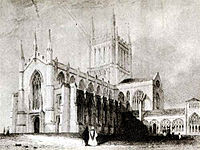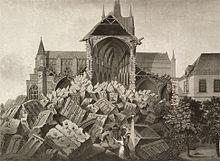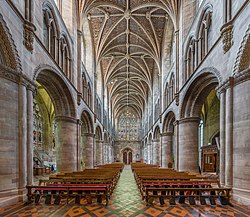Hereford Cathedral
| Hereford Cathedral | |
|
Cathedral Church of | |
|---|---|
|
Hereford, Herefordshire | |
| Status: | cathedral |
 Hereford Cathedral | |
| Church of England | |
| Diocese of Hereford | |
| Location | |
| Grid reference: | SO510397 |
| Location: | 52°3’15"N, 2°42’58"W |
| History | |
| Built 1110-c.1250 | |
| Romanesque and Gothic | |
| Information | |
| Website: | www.hereford cathedral.org |
Hereford Cathedral stands in the heart of Hereford, the county town and sole city of Herefordshire. It is a magnificent Romanesque Norman cathedral within a Gothic shell, dating from 1079 which serves as the cathedral of the Diocese of Hereford and the seat of the Bishop of Hereford.
The most famous treasure in the cathedral is the Mappa Mundi, a mediæval map of the world dating from the 13th century.
The cathedral is a Grade I listed building.[1]
Contents
History
Origins
Hereford has been the seat of a bishopric possibly as early as the 6th century. In the 7th century a cathedral was refounded by Putta, who settled here when driven from Rochester by Æthelred of Mercia.
Part of the dedication of today's cathedral is to St Ethelbert the King: he was beheaded by Offa, King of Mercia in the year 792 and his body brought to Hereford by 'a pious monk'. (Offa had consented to give his daughter to Ethelbert in marriage: why he changed his mind and deprived him of his head historians do not know, though tradition claims the bride's mother was jealous of her daughter's happiness.) At Ethelbert's tomb miracles were said to have occurred, and in the next century (about 830) Milfrid, a Mercian nobleman, built a stone church over the tomb, dedicated to Ethebert.
Milfrid's cathedral stood for some 200 years. In the reign of Edward the Confessor it was altered, but this new church was plundered and burnt in 1056 by a combined force of Welsh and Irish under Gruffydd ap Llywelyn and was left in ruin.
Norman period
In 1079 Robert of Lorraine was consecrated bishop and began a new cathedral, completed under Robert de Betun, who was Bishop from 1131 to 1148. Of this Norman church, the choir up to the spring of the clerestory, the south transept, the arch between the north transept and the choir aisle, and the nave arcade are the best surviving structures. It was not left in peace, for within 50 years new additions and improvements carged the building.
Peter of Aigueblanche, a Frenchman who came in the train of Eleanor of Provence, and also known as Bishop Aquablanca, rebuilt the north transept. A man of energy, resource, ingenuity and unabashed corruption, he lavished money upon the cathedral and made a handsome bequest to the poor. When Prince Edward came to Hereford to deal with Llywelyn the Great of Gwynedd, the Bishop was away in Ireland on a tithe-collecting expedition, and the dean and canons were also absent. Not long after the Bishop's return, which was probably expedited by the stern rebuke which the King administered, he and all his relatives from Savoy were seized within the cathedral by a party of barons, who deprived him of the money which he had extorted from the Irish.
14th to 16th century: completion of the fabric
In the first half of the 14th century the rebuilding of the central tower, which is embellished with ball-flower ornaments, was carried out. At about the same time the chapter house and its vestibule were built, then Bishop Trevenant (1389 to 1404), rebuilt the south end and groining of the great transept. Around the middle of the 15th century a tower was added to the western end of the nave and later additions grew until the north porch, now forming the principal northern entrance was at last added, 440 years after the cathedral was built.
Thomas de Cantilupe was a forceful bishop (when Lord Clifford's men assaulted some episcopal tenants and raided their cattle, Clifford was condemned to walk barefoot through the cathedral to the high altar, and the bishop himself applied the rod to his back). Bishop Cantilupe alo seized back several manor taken by Llewellyn and sued the Earl of Gloucester for possession of a chase near the Forest of Malvern; this may be the origin of the Shire Ditch running along the riodge of the Malvern Hills. He dies in Itlay after being excommunicated by the Archbishop of Canterbury, was canonised in 1320 and his arms were adopted for those of the see.
16th to 18th century
In the Civil War, Hereford was held for the King then taken for Parliament. The victorious Parliamantarians ran riot in the cathedral and caused great damage.
In the early years of the 18th century, Bishop Bisse (1712–21), devised a scheme to support the central tower. He also had installed an enormous altar-piece and an oak screen, and instead of restoring the Chapter House he allowed its stones to be utilised for alterations to the Bishop's Palace. The bishop's brother, the Rev Dr Thomas Bisse, was the Chancellor of the Cathedral and in 1724 he organised a "Music Meeting" which subsequently became, with the Cathedrals at Worcester and Gloucester, the Three Choirs Festival.
1786: Fall of the western tower
On Easter Monday, 1786, the west tower fell, creating a ruin of the whole of the west front and at least one part of the nave. The tower had a general resemblance to the central tower; both were profusely covered with ball-flower ornaments, and both terminated in leaden spires. James Wyatt was called in to repair the damage. Instead of just repairing, he made alterations which were not universally popular.
19th-century restoration
In 1841 the restoration work was begun. Bishop Bisse's poor masonry was swept away from the central tower, the lantern was strengthened and exposed to view, and much work was done in the nave and to the exterior of the Lady Chapel. Later George Gilbert Scott and progressed the work until the cathedral could open again in 1863. On the occasion the Bishop of Hereford, Dr Hampden, preached in the morning and Bishop Wilberforce preached in the evening. In his diary, Wilberforce characterises his right reverend brother's sermon as "dull, but thoroughly orthodox"; but of his own service he remarks (not without complacency), "I preached evening; great congregation and much interested."
The west front was restored by John Oldrid Scott over the period 1902 and 1908.[2]
Since them these restorations much else has been done. "Wyatt's Folly", as James Wyatt's west front was often called, has been replaced by a highly ornate façade in commemoration of the Diamond Jubilee of Queen Victoria, whose figure is to be seen at the beautiful stained glass which fills the seven-light (i.e. with seven main vertical "lights", or sections of glass) window subscribed "by the women of Hereford diocese".
20th and 21st centuries
A new library building was constructed in the early 1990s and opened by HM The Queen in 1996.[3] In 1967 with the new liturgical fashion, the magnificent Scott Rood Screen was removed in pieces and discarded. It has since been restored and is now in the Victoria and Albert museum.
Work on a new Cathedral Green, with pathways, seating, and gated entrance to the Cathedral was undertaken in 2010 to 2011 and in 2015 landscaping and restoration efforts at the Cathedral were completed, requiring the lifting and reburial of thousands of corpses.[4]
The interior
There is decorative work on the Norman architecture columns and arches of the nave built by Bishop Reynelm's stonemasons. Until 1847 the pavement which had been laid down in the nave completely hid the square bases on which the piers rest. Double semi-cylindrical shafts run up their north and south faces, ending in small double capitals at the height of the capitals of the piers themselves. In the south aisle of the nave are two 14th century church monument tombs, with effigies of unknown ecclesiastics. The tomb of Sir Richard Pembridge, Knight of the Garter in the reign of Edward III, is a fine example of the armour of that period, and it is one of the earliest instances of an effigy wearing the garter. A square-headed doorway gives access from this aisle to the Bishop's Cloister.
At the northern entrance is a porch and Decorated doorway, a good general view is at once obtained. There is a modern rood screen, a spacious and lofty central lantern, and a reredos with a carved spandrel. The Lady Chapel has lancet windows, foliated ornaments and a groined roof. The tomb of Bishop Booth, the builder of the porch, is in the sixth bay of the nave on the north side, guarded by the only ancient ironwork left in the cathedral. On the south side of the nave is the Norman font, a circular bowl large enough to allow of the immersion of children.
Great transept and choir
The north transept is remarkable for the diapering of the triforium arcade, and for the form of the pointed arches and windows, which have so slight a curvature as to resemble two straight lines meeting at an angle. The north window is filled with stained glass by Hardman as a memorial of Archdeacon Lane-Freer, who died in 1863. In this transept is the tomb or substructure of the shrine of Bishop Cantilupe, early Decorated work which has been restored. Of Purbeck marble, it is built in two stages, of which the lower contains 14 figures of Knights Templars in chainmail armour, occupying cinquefoiled niches; the Bishop was Provincial Grand Master of that Order in England. Between the north choir aisle and the eastern aisle of the transept is the tomb of Bishop Aquablanca, the most ancient of the episcopal monuments in the church. The effigy is an example of a bishop in full vestments; the canopy is supported by slender shafts; the carving throughout is delicate. The south transept is thought by some authorities to be the oldest part of the cathedral, and it exhibits some Norman work, notably the eastern wall with its arcades.
The choir, consisting of three Norman bays of three stages, is full of objects of beauty and interest. The reredos, designed by the younger Cottingham, consists of five canopied compartments, with elaborate sculpture representing our Lord's Passion. Behind it is a pier from which spring two pointed arches; the spandrel thus formed is covered with rich modern sculpture, representing Christ in his majesty, with angels and the four Evangelists; below is a figure of King Ethelbert. Against the most easterly point on the south side of the choir is to be seen a small effigy of the king, which was dug up at the entrance to the Lady Chapel about the year 1700. The Bishop's throne and the stalls, of 14th century work and restored, and the modern book desks and figures of angels on the upper stalls, deserve attention. There is also a very curious ancient episcopal chair.
The choir stalls support forty 14th-century misericords showing a mixture of mythological beasts, grotesques and everyday events. In addition to the misericords in the choir, there are five others contained in a row of "Judges Seats": it is unclear if these were used as misericords, or if they are just ornamentation.
Music
Bells
Hereford Cathedral houses 10 bells 140 feet up in the tower. The tenor bell weighs 34 cwt. The oldest bell in the Cathedral is the sixth which dates back to the 13th century. The bells are sometimes known as the "Grand Old Lady" as they are a unique ring of bells.
The Cathedral is the main tower of the Hereford Diocesan Guild.[5]
Organ
On the south side of the choir is an organ built in 1892 by Henry Willis, generally considered to be one of the finest examples of his work in the country.
Mappa Mundi
On the wall of the opposite choir aisle, the celebrated Hereford Mappa Mundi, dating from the later years of the 13th century, hung, little regarded, for many years. It is the work of an ecclesiastic who is supposed to be represented in the right-hand corner on horseback, attended by his page and greyhounds. He has commemorated himself under the name of Richard de Haldingham and Lafford in Lincolnshire, but his real name was Richard de la Battayle or de Bello. He held a prebendal stall in Lincoln Cathedral, and was promoted to a stall in Hereford in 1305.
During the troubled times of Cromwell the map was laid beneath the floor of Bishop Audley's Chantry, beside the Lady Chapel, where it remained secreted for some time. In 1855 it was cleaned and repaired at the British Museum. It is certainly one of the most remarkable monuments of its kind in existence, being the largest but one of all the old maps, drawn on a single sheet of vellum. The world is represented as round, surround by the ocean. At the top of the map (the east) is represented Paradise, with its river and tree; also the eating of the forbidden fruit and the expulsion of Adam and Eve. Above is a remarkable representation of the Day of Judgment, with the Virgin Mary interceding for the faithful, who are seen rising from their graves and being led within the walls of heaven. There are numerous figures of towns, animals, birds, and fish, with grotesque creatures; the four great cities, Jerusalem, Babylon, Rome, and Troy, are made very prominent. In Britain most of the cathedrals are mentioned.
In the 1980s, a financial crisis in the diocese caused the Dean and Chapter to consider selling the Mappa Mundi. After much controversy, large donations from the National Heritage Memorial Fund, Paul Getty and members of the public, kept the map in Hereford and allowed the construction of a new library to house the map and the chained libraries from the Cathedral and All Saints' Church. The centre was opened on 3 May 1996.
East transept
In the north-east transept, of which the vaulting is supported by a central octagonal pier, a large number of monumental fragments are preserved, forming a rich and varied collection. There is also a beautiful altar-tomb of alabaster and polished marbles erected as a public memorial to a former Dean, Richard Dawes, who died in 1867. The effigy, by Mr. Noble, is a good likeness of the Dean, who was an ardent supporter of the education movement about the middle of the 19th century. The south-east transept contains memorials of several Bishops of Hereford. The remains of Bishop Gilbert Ironside (1701), together with his black marble tombstone, were removed to this place in 1867 m, when the Church of St. Mary Somersetm in Upper Thames Street, London, was taken down. Here also may be seen a curious effigy of St John the Baptist, and a fine marble bust, believed to be the work of Roubiliac. The handsome canopied Perpendicular tomb of Bishop Mayo (1516), with effigy fully vested, is on the south side of the altar. In the south-east transept, again, is a doorway that opens into the Vicars' Cloister, an interesting piece of Perpendicular work which leads to the college of the vicars choral.
Crypt and library
Though the crypt is small, it is of special interest, as the solitary example of a crypt built after the Norman period until we come to Truro Cathedral, the crypt of St Paul's being only a reconstruction. To its use as a charnel house it owes the name of Golgotha.
The library contains mainly old books in manuscript chained to their places, some of them fine specimens of ancient handwriting, containing beautiful illustrations in gold and colour. Two of the most valuable are a unique copy of the ancient Hereford antiphonary of the 13th century, in good preservation, and the Hereford Gospels, a copy of the Gospels at least a thousand years old, in Anglo-Saxon characters. Another treasure is an ancient reliquary of oak, bequeathed to the cathedral by Canon Russell, who is said to have obtained it a family in whose possession it had long been. It is covered with copper plates overlaid with Limoges enamel representing the murder and entombment of St Thomas of Canterbury.
Magna Carta
Hereford is fortunate to possess one of only four 1217 Magna Carta to survive, which in turn is one of the finest of the eight oldest that survive. It is sometimes put on display alongside the Hereford Mappa Mundi in the cathedral's chained library.
Pictures
Outside links
| ("Wikimedia Commons" has material about Hereford Cathedral) |
- Official site
- Mappa Mundi
- A history of the choristers and choir school of Hereford Cathedral
- Flickr images tagged Hereford Cathedral
- "The Hereford Screen". Metalwork. Victoria and Albert Museum. http://www.vam.ac.uk/collections/metalwork/metalwork_stories/hereford/index.html. Retrieved 22 September 2007.
References
- ↑ National Heritage List 1196808: Hereford Cathedral
- ↑ Nikolaus Pevsner: The Buildings of England: Herefordshire, 1963; 2012 Penguin Books ISBN 978-0-300-12575-7
- ↑ "New Library Building". http://www.herefordcathedral.org/visit-us/mappa-mundi-1/new-library-building. Retrieved 29 June 2015.
- ↑ Geggel, Laura (14 April 2015). "Battered Remains of Mediæval Knight Discovered in UK Cathedral". MSN News. http://www.msn.com/en-us/news/world/battered-remains-of-mediæval-knight-discovered-in-uk-cathedral/ar-AAaYPcx.
- ↑ Dove, Ronald H. (1982). A Bellringer's Guide to the Church Bells of Britain and Ringing Peals of the World (6th ed.). Guildford: Viggers.
- The Cathedrals of England and Wales: their history, architecture, and associations, 1906, (Cassell) pages 17-30
| Cathedrals of the Church of England |
|---|
|
Province of York:
Blackburn •
Bradford •
Carlisle •
Chester •
Durham •
Liverpool •
Manchester •
Newcastle upon Tyne •
Peel •
Ripon •
Sheffield •
Southwell •
Wakefield •
York
|













